Last updated on August 23rd, 2022
Have you ever reached for your cast iron skillet and realized it felt a little sticky? Or, maybe you’ve just finished seasoning your pan and you’re discouraged to find a blotchy, uneven seasoning layer that feels tacky or gummy. So, what makes cast iron sticky? Why does it happen, and what can you do to fix and prevent it?
In short, cast iron stickiness is caused by a buildup of excessive oil. This can happen by using too much oil to season the pan, using the wrong type of oil, if the oven temperature is not hot enough to cause the oil to polymerize and harden, or if the pan is not heated long enough in the oven.
If this has happened to your skillet, don’t worry! It’s actually pretty easy to fix sticky cast iron and restore a smooth, well-seasoned finish. Keep reading as we take a more in-depth look at why your cast iron pans get sticky, simple ways to remove gummy residue, and how to prevent your cast iron from becoming sticky in the future.
The Science Of Cast Iron Seasoning
To understand why cast iron becomes sticky, let’s learn a little bit about the science of seasoning. When you know how the process should work, it’s much easier to identify where things went wrong and correct the problem.
The first step in the seasoning process involves applying a very light coating of oil to the cast iron. I like to use a cotton or microfiber lint-free cloth for applying the oil to the pan. Once the oil is applied, use another cloth to buff all surfaces of the pan to remove excess oil. You want to wipe it off really well, as if you’re trying to remove all the oil you just applied. There will still be plenty of oil in the tiny pores of the iron to produce a good seasoning layer and you won’t have a streaky, sticky mess.
Next, the pan is heated upside down in an oven at a high temperature for about an hour. The temperature needed to season the pan depends on the type of oil used. The oil will need to be heated above its specific smoke point in order to properly polymerize. (Read more about oil-specific smoke points here).
Polymerization is a chemical reaction that occurs between the oil, iron, and oxygen, that causes it to form a hard, shell-like coating on the surface of the pan. When seasoned correctly, your skillet should feel smooth with an almost mirror-like finish. There should be no liquid oil remaining in the pan. The iron should not look splotchy or feel sticky or gummy to the touch.
The seasoning layer is what helps prevent food from sticking to the pan when cooking. It also protects the iron from oxidation, therefore preventing rust from forming. In the next section, we’ll take a look at why your skillet might feel sticky after seasoning it.
For more on how to season cast iron, including which oils are best and the temperature required for each oil, check out my popular article, Seasoning Cast Iron Cookware: A Step-By-Step Guide.
Why Is My Cast Iron Skillet Sticky After Seasoning It?
If you recently seasoned your cast iron pan and it is sticky, gummy, or blotchy, it is likely due to one or more of these reasons:
The Pan Wasn’t Clean Prior To Seasoning It
If your cast iron pan isn’t completely clean and has traces of food, grease, or leftover cooking oil on it, the seasoning oil won’t properly bind with the iron. It’s always best to thoroughly scrub your cookware with a sponge, nylon scrub brush, or chain mail scrubber and dish soap before seasoning it.
Yes, it’s okay to use soap, especially since you’re about to re-season the pan. For more on using soap to clean cast iron, check out this article.
You Used Too Much Oil For Seasoning
This is, by far, the most common reason cast iron feels sticky after seasoning.
When it comes to how much oil you need to season a cast iron pan, less is more. Think of it like this: When painting a wall, you don’t want to slop on one thick coat of paint in an effort to fully cover the original wall color underneath. That would just result in a runny, drippy mess that would be quite gunky and sticky. Instead, you would evenly apply multiple thin coats of paint, letting each coat dry completely before applying the next.
The same is true when seasoning cast iron. Seasoning works best when it is performed in multiple rounds (usually 2-4) using very small amounts of oil. After each layer of oil is applied and buffed off, the pan will need to be heated in the oven for an hour. Then, allow it to cool somewhat before undergoing the next round of oiling and heating.
Make sure to place your pan upside down in the oven when seasoning it. This prevents oil from dripping down the sidewalls and settling in the bottom of the pan.
Using The Wrong Type Of Oil Or Fat For Seasoning
Many people think any type of oil or fat will work when seasoning cast iron. This may be true to some extent. However, the quality of the seasoning layer definitely depends on the type of oil you use.
The two most important factors in determining which oil to use for seasoning are 1: The type of fat it contains (saturated vs unsaturated), and 2: The smoke point of the oil.
- Saturated fats: Butter, lard, animal fat, and bacon grease all contain higher amounts of saturated fats and they are solid at room temperature. They don’t work as well for seasoning because saturated fat molecues don’t bond well with other molecules (i.e. cast iron). This can result in patchy, flaky, uneven seasoning. Food may be more likely to stick to the pan when cooking, particularly if the cast iron has a rough cooking surface.
- Unsaturated fats: Unsaturated fats are liquid at room temperature and include most cooking oils. They easily bond with other molecues, which creates a stronger, more uniform seasoning layer on the cast iron that is easier to cook with and clean. A solid seasoning layer created with unsaturated fat is also more receptive to additional layers of seasoning.
Oil Smoke Point
Every oil has a smoke point, which is the high temperature at which the oil begins to break down and smoke is produced. If the oil is not heated beyond its smoke point, it will not completely break down and bond with the iron. This will leave behind a brown, sticky layer of oil that is prone to turning rancid instead of a nice shiny, black, easy-release finish.
Check out this helpful seasoning oil comparison chart for guidance on the smoke points and recommended oven temperatures for seasoning based on each oil type.
Attempting To Season A Cold Pan
As with any metal, cast iron expands slightly when heated. This allows the seasoning oil to seep deeper into the pores of the iron and create a stronger bond during the seasoning process. If you apply oil to a cold pan, it tends to sit more on the surface of the iron instead of settling into the tiny pores. As a result, you are more likely to end up with an uneven or sticky seasoning layer.
This is why I recommend pre-heating the pan at 200 degrees for about 10 minutes prior to applying the oil. Once it is warm, carefully remove the pan from the oven and apply the thin layer of oil. Wipe the pan with a lint-free cloth to remove any excess oil. Then, place the pan back into the oven for a full hour of seasoning at the appropriate temperature.
Oven Temperature Was Not Hot Enough
This is another common reason for ending up with a sticky skillet after seasoning. As mentioned previously, in order for the oil to break down and bond with the cast iron, it must be heated above its smoke point. When you heat oil above its smoke point, it will result in the production of a little bit of smoke, which is completely normal.
This is where many people go wrong. They see or smell a bit of smoke coming from the oven, assume it is too hot, and turn down the temperature. While this may stop the smoky smell, it’s also stopping the polymerization reaction needed to produce the seasoning layer on the pan. Keep your oven heated to the recommended temperature, typically between 450 and 500 degrees Fahrenheit based on the type of oil, for the entire hour.
Not Heating Cast Iron In The Oven Long Enough
In order for proper seasoning to occur, the oiled cast iron cookware must remain in a hot oven for about an hour. Taking the pan out of the oven too soon halts the seasoning process. This causes the oil to remain in a liquid state on the iron. When it cools, the pan will feel sticky.
To fix this, simply place the pan back in the oven at 450 to 500 degrees Fahrenheit for an hour. Note that the pan may appear splotchy and will likely require multiple rounds of seasoning.
Seasoning The Pan On The Stovetop
Seasoning a cast iron pan on the stovetop may seem like a faster and easier solution than heating it in the oven. But, this method is almost guaranteed to result in a patchy or sticky pan.
The heat generated by stovetop burners is very uneven. It will heat the pan to a very high temperature, but only in the bottom area that is in direct contact with the burner. The outer edges and sidewalls of the pan may not get hot enough to polymerize the oil. This results in sections of the pan becoming seasoned while others remain coated in liquid oil. This is why it’s always best to season cast iron cookware in the oven for even heating.
Why Did My Cast Iron Skillet Get Sticky Between Uses?
Maybe your cast iron skillet has been properly seasoned, but you find it becoming sticky between uses. This could be due to oil, grease, or food residue being left in the pan after cooking.
Or, perhaps you care for your skillet meticulously – washing, drying, and re-oiling it after each use. But, the next time you get your pan ready to cook dinner, it feels sticky. What gives? I was frustrated by this problem too when I was fairly new to cast iron care.
What’s causing the stickiness? Typically, it’s because you’re applying too much oil to the iron prior to storing it. Even if it doesn’t look like any oil is running or dripping, make sure to wipe down all the surfaces thoroughly with a lint-free cloth after applying the oil. Otherwise, as it sits, the liquid oil starts to oxidize and thicken, giving it that sticky, gummy feeling. It can even make your cast iron smell musty.
Can You Cook With A Sticky Cast Iron Skillet?
While cooking with a sticky cast iron skillet certainly isn’t the worst thing you could do to your pan, it’s not advisable. Since the stickiness is already being caused by an excess of oil or grease build-up, adding more oil or fat to the pan when cooking will just compound the problem. Your pan will likely end up with a thicker layer of gummy residue that will be harder to remove.
In addition, cooking with sticky cast iron will likely cause the food you’re cooking to stick to the pan. It can also infuse an oxidized oil taste into your food, giving it a stale flavor.
If your cast iron pan feels sticky to the touch or there is visible gummy residue present, clean the pan thoroughly before using it again. Depending on the cleaning method required to remove the stickiness and the condition of the seasoning layer, you may need to season your pan again prior to using it.
How Do I Clean A Sticky Cast Iron Pan?
To clean a sticky or gummed-up cast iron pan, simply follow these steps:
1. Wash the pan thoroughly with warm water and dish soap. Avoid letting the pan soak to prevent rust from forming. Once the cast iron is no longer sticky, dry it thoroughly, then place it on a stovetop burner over medium heat for 2-3 minutes to evaporate any remaining moisture. Once dry, apply a very thin layer of oil all over the pan with a lint-free cloth and wipe away any excess.
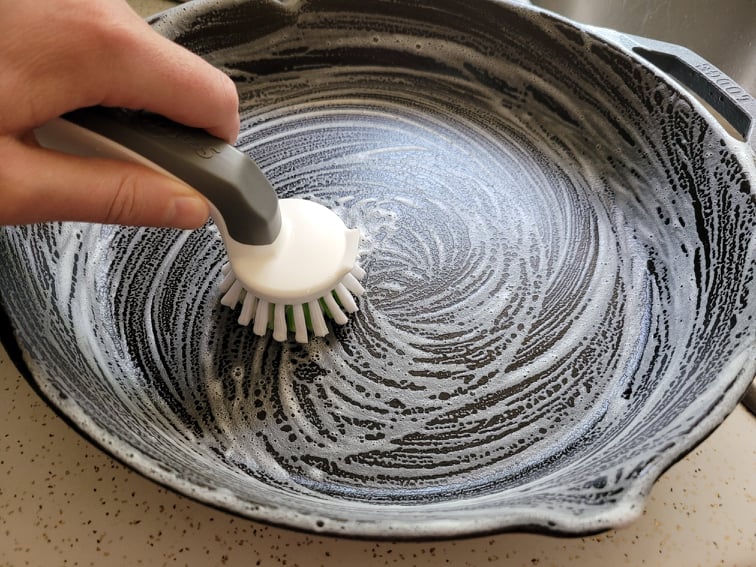
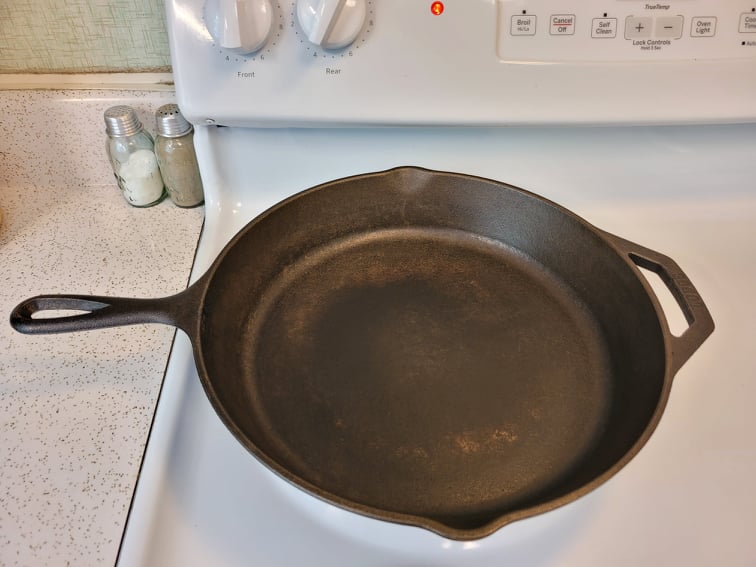
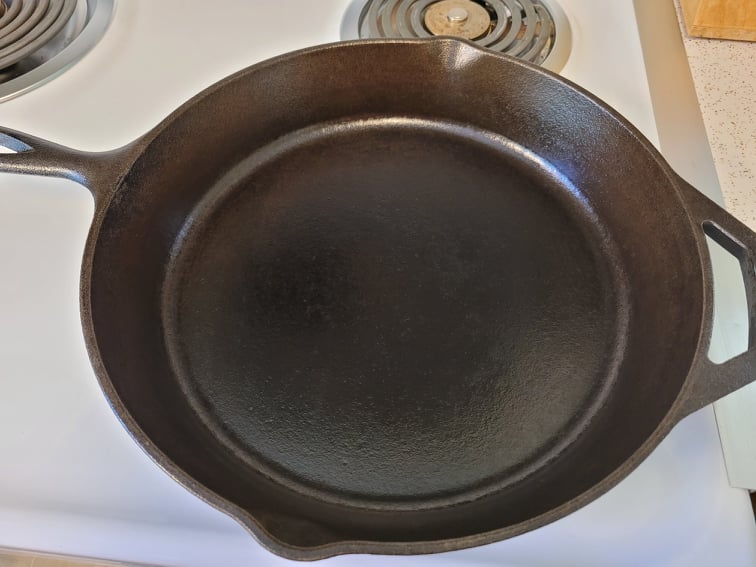
2. If the pan is still sticky, scrub it with coarse salt or a chain mail scrubber.
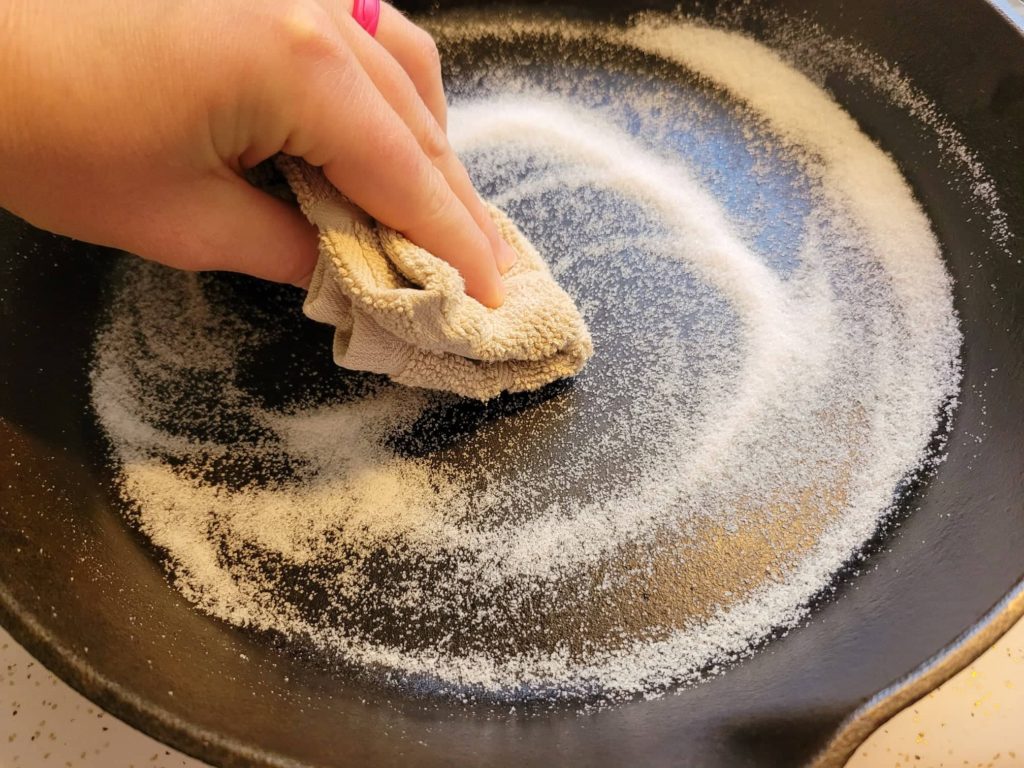

3. If your cast iron pan is still sticky after washing and scouring, you may need to use steel wool to remove gunky oil build-up. Make sure to only use steel wool, not bronze or copper, as these can discolor the pan. Because steel wool is so abrasive, it will likely remove a portion of the seasoning layer. Your pan may require multiple rounds of re-seasoning afterward.
How To Properly Season A Cast Iron Pan
To season your cast iron pan, follow these easy steps:
1. Clean Pan Thoroughly: Wash your cast iron pan with soap and water to remove oily residue, grease, dirt, or dust that would interfere with the seasoning layer bonding to the iron.
2. Dry Pan Completely: Wipe the pan dry with a towel, then heat it on a stovetop burner over medium heat for 2-3 minutes to evaporate any remaining moisture. Don’t let cast iron drip dry, as this will cause it to rust.
3. Pre-Heat and Lightly Oil Pan: Pre-heat the pan in the oven at 200 degrees Fahrenheit for 10 minutes. This better prepares the iron to accept the coating of oil that will soon be transformed into a layer of seasoning. Carefully remove the pan from the oven and apply a very light coat of oil to both the inside and outside of the pan with a lint-free cloth. A little bit goes a really long way! Then, use another cloth to buff all surfaces of the pan to remove excess oil. Wipe it off really well, as if you’re trying to remove all the oil you just applied.
4. Heat Pan In Oven: Place the cast iron pan upside down in the oven at the recommended temperature based on the type of oil you’re using, typically between 450 and 500 degrees Fahrenheit. (See this chart for recommended oil types and oven temperatures). Let the pan remain in the oven for one hour, then turn off the oven. Crack the oven door open a few inches and let the pan gradually cool off until it is safe to handle.
5. Oil, Heat, Repeat: The key to successful, near-bulletproof cast iron seasoning is the application of multiple, thin layers of seasoning. Repeat the oiling and heating process two to four times to build up a really strong, easy-release finish.
Summary
Hopefully, you now have a better understanding of why cast iron cookware gets sticky and how to fix and prevent it! For more information on cast iron seasoning, check out my comprehensive article, Seasoning Cast Iron Cookware: A Step-By-Step Guide, or my Cast Iron Seasoning Quick Guide, complete with a printable infographic for easy reference.
Need some cooking inspiration? Be sure to check out the Recipes section of the blog for delicious and easy recipes you can make at home or while camping!
Recommended Products
This post may contain affiliate links. This means if you click on a link and make a purchase, I will receive a small commission, at no cost to you, that makes it possible for me to keep the Campfires and Cast Iron site up and running. Please see our disclosure policy for details.
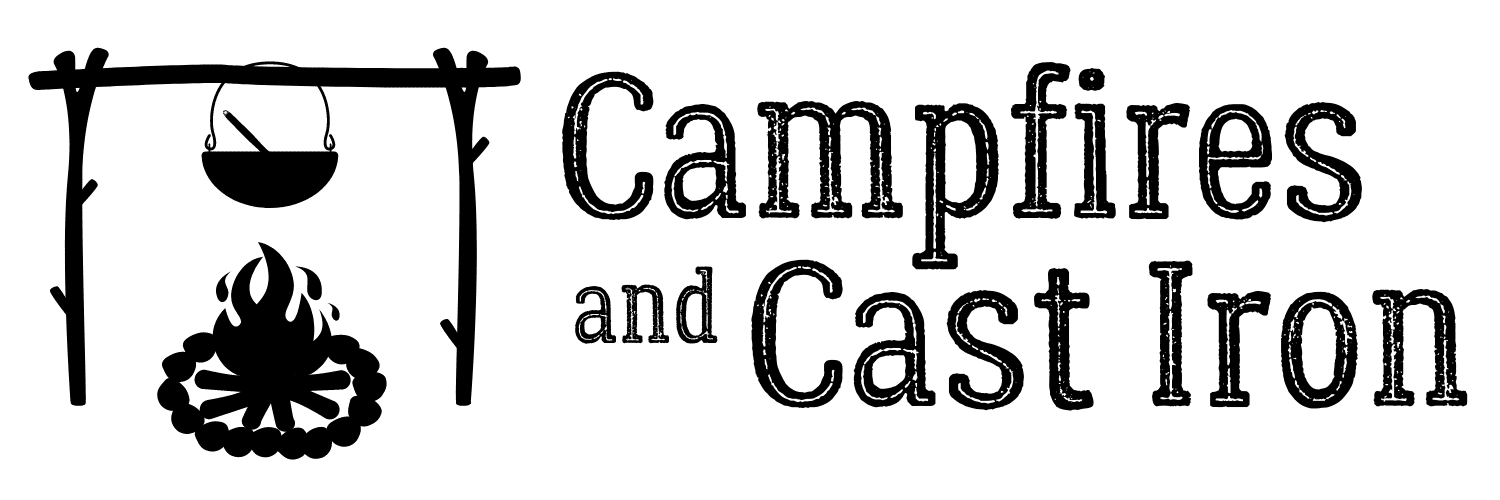









Hello Stacy,
Cant believe no one has commented on the thoroughness of your “blog”?
Sorry, a bit computer challenged.
Just wanted to say thanks for your efforts as you have provided the info i need to fix a 12 incher that, as i had already guessed, used way too much oil to season.
Haven’t wanted to use it for months cause i made a “sticky mess”.
Now, thanks to you, I will begin the process to fix it.
Got a chuck roast that needs browning for a big ol pot of chilli.
Sending love,
Mike
I REALLY hate the idea of going through 4 hours at 500 degrees in my oven. It just seems so excessive for the result. Unless the result lasted literally months. I have always superheated the oil that I use with each cooking, let it cook some and then cooked my food in that, and usually that causes things not to stick.
I really cannot do the 500 degrees for 4 hours. We recently worked on our oven because some elements went out and now I’ve always been scared to continuously run it at high temps.